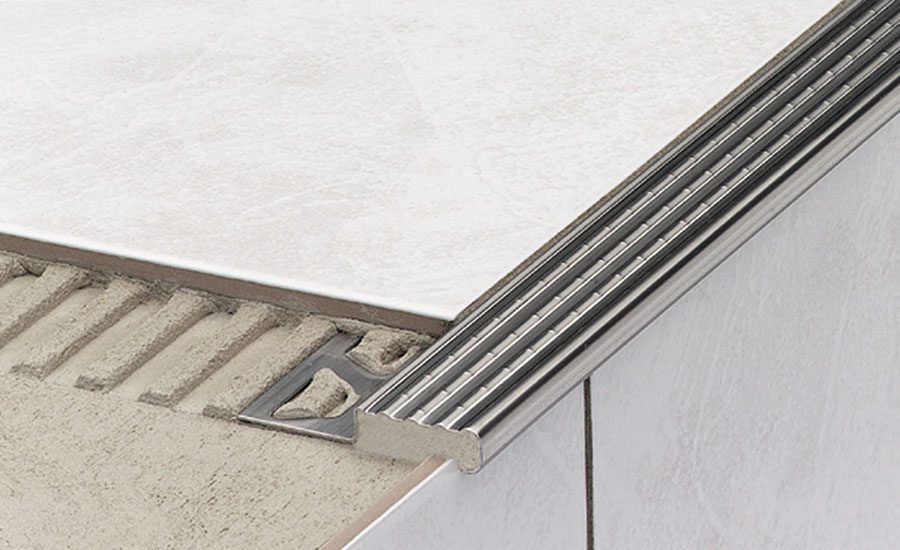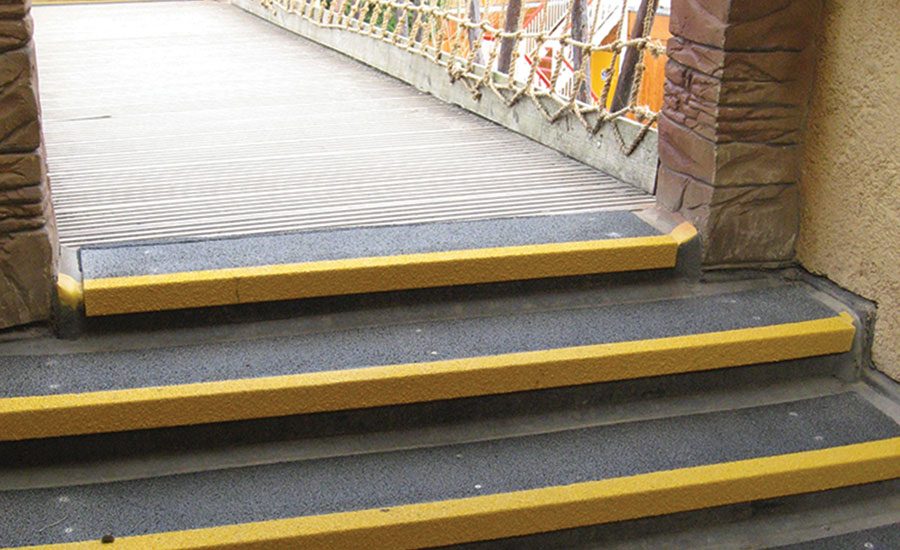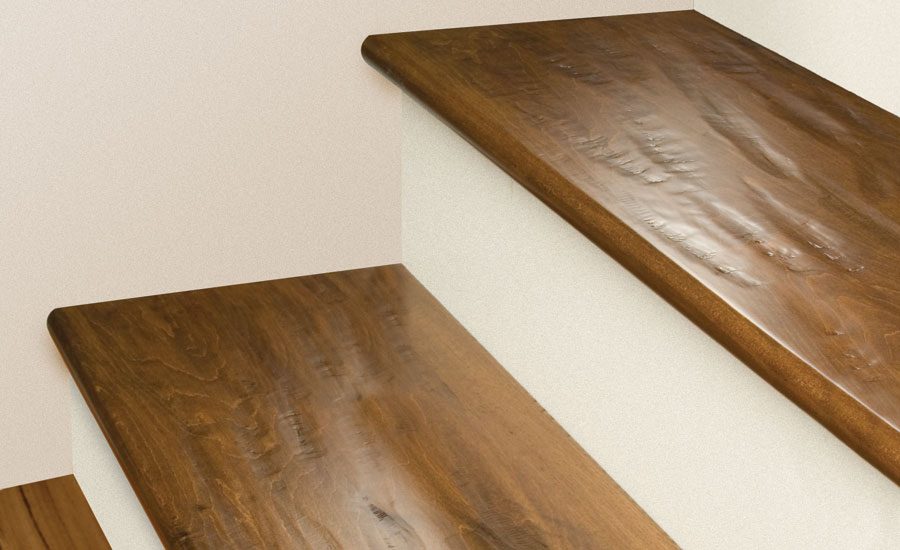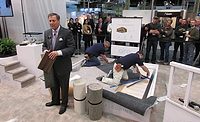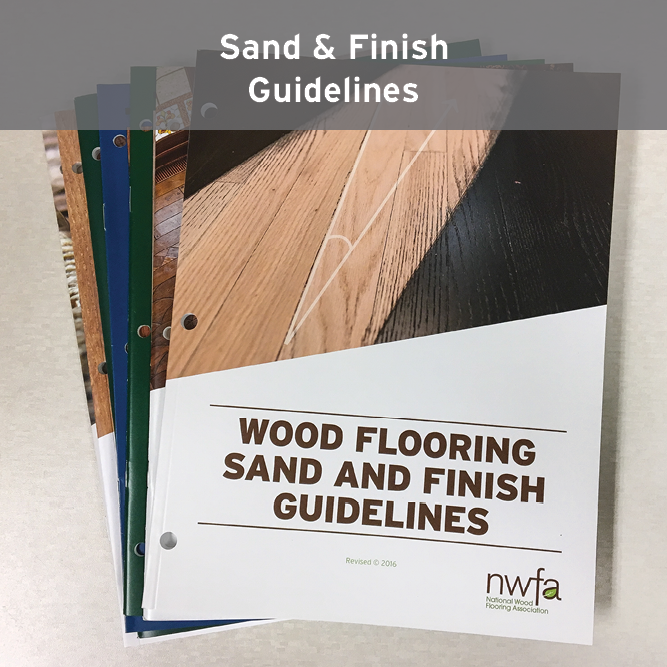Installing hard-surface stair treads—whether hardwood, laminate, vinyl, rubber or tile—may seem like a daunting task. But as manufacturers across the segment explain, it doesn’t have to be. As long as installation instructions are followed, measurements and cuts are carefully made, and potentially project-ending shortcuts are avoided, building a set of stairs is something that any installer can add to their skill set.
Basic tools
According to Bill Treiber, technical sales and education manager for Artistic Finishes, installers should have the following tools ready for installing hard-surface stair treads: “a table saw, skill saw and/or compound miter saw, T-square and/or stair jig, level, tape measure, utility knife, hammer, nail punch, finishing nails (#6 to #8s), elastomeric construction adhesive, caulking gun, finishing nail gun and safety goggles.”
Don Styka, Tarkett’s director of field services, recommends “a tape measure, dividers, under-scribers (used to fit the riser to the underside of the tread nose for rubber and vinyl treads), carpenter square, straight edge, and a good marking pencil so you can see your marks and lines.”
He added, “The cutting tools will vary depending on the stair tread materials. Rubber and vinyl treads can be cut using a utility knife, while the more rigid products require a power saw. Whether a utility knife or power saw is used, the installer should always have a sharp blade to provide good, clean cuts and finished results.”
Mike Pigeon, technical installation specialist for Roppe Holding Co., listed similar tools, as well as “a scraper, small hand broom, clean rags and some denatured alcohol. Be sure you have the appropriate dual-cartridge epoxy applicator gun for the nose filler when using cartridges. Some blue painter’s tape and pencil will also help for marking tread locations for scribing.”
Sean Gerolimatos, director of research and development at Schluter Systems, noted that in addition to tile-setting tools installers will need the appropriate cutting tools for metal profiles. “Different tools will be required depending on the profile material. For example, aluminum profiles may be cut using a hacksaw with a bimetal blade—ideally with the highest teeth per inch (TPI) available—a chop saw or miter saw with a nonferrous blade, or an angle grinder with appropriate cutting wheel.
“Stainless steel profiles may be cut using an angle grinder with an appropriate cutting wheel or a band saw with a metal cutting blade. The Schluter Procut-TSM cutting wheel is suitable for use with both aluminum and stainless steel.”
According to Greg Gelston, Profilitec’s president, installers working with quality stair tread products shouldn’t worry about needing any specialized tools. “These stair tread solutions should integrate into the assembly using the same tools they would use to install the selected floor covering.”
He added, “This is the purpose of the perforation on the base of most profiles: to allow the adhesive to effectively engage and solidly embed the tread profile into the assembly. In some cases and for some floor covering products, mechanical fastening to attach the tread to the substrate may be specified, which requires basic mechanical fastening devices that are commonly included in most installers’ bag of tools.”
Darren Richardson, owner of Dino Grip (dinogrip.com), said his company’s anti-slip treads are designed to be installed over almost any type of stair substrate. For installation of the company’s treads, he recommends “a drill gun and screws, or if [installed over] metal, it would be a combination of a drill and rivet gun.”
Common mistakes
Ivan Stoler, president of Allstate Rubber Corp., said the biggest mistake he sees in the installation of stair treads is not performing a field measurement before beginning the installation. “Sometimes the stair builder actually adds to the width or depth. However, the print lists the original measurements.”
Richardson echoed those sentiments. “A common mistake is cutting [the treads] too large or not checking that the step is square. A lot of the time people just assume it’s square when it’s not.”
Treiber noted that anyone with basic carpentry skills should be able to install stairs, but first they should familiarize themselves with local and state building codes as well as the different terms used for stair construction. “These terms start with the stair body and include skirt board, tread, starter step, riser, landing tread, decorative tread bracket, cove and shoe moldings, along with tread and riser caps. Most, if not all, of these items will come into play when installing treads.”
Gelston stated that contractors need to be certain a tread is appropriate for the setting where it’s planned to be installed. “Premature wearing and/or detachment of a tread not intended for that particular traffic level can be a very dangerous hazard. For example, tread material designed specifically for residential applications is generally inadequate for the demands of a shopping mall.
“Further, there are ADA (Americans with Disabilities Act) requirements for the width and color of treads used by the public that must be respected. Installers and specifiers should take measures to know the code requirements of a particular application and the suitability of the products that are being specified and installed.”
Gerolimatos added that tiled stair edges without trim pieces are vulnerable to chipping and breaking, which can create a trip hazard. “Stair nosing profiles, such as those found in the Schluter Trep product family, can be used to protect tile edges and improve safety on tiled stairways by providing slip-resistant wear surfaces and increased visibility. Some profiles feature tread surfaces that can be replaced in case of damage or wear, which is an excellent feature for commercial applications especially.”
He commented that several considerations need to be made when planning out the project. “The first step is to select an appropriate product depending on the expected traffic. It is also very important to select the correct size according to the thickness and format of the adjacent tile. If the profile is too small the tile edges will be exposed, producing unsightly results and risk of damage; if the profile is too tall it can create a trip hazard.
“In addition to choosing a suitable cutting tool, you must use it in a safe and appropriate manner. For example, if you plan to use an angle grinder to cut stainless steel profiles, it’s important to use a variable-speed angle grinder set to the lowest speed, since running a grinder on high speed or trying to cut stainless steel profiles too fast can result in warping and discoloration of the metal.
“Finally, it is essential that full thin-set mortar coverage is achieved during installation to support the stair nosing profile and tile. This may require filling the underside of the profile with thin set mortar. Always read and follow the manufacturer’s instructions.”
Pigeon shared his experience of some of the issues that can arise when manufacturer instructions aren’t followed. “One common mistake is not doing a snug scribe fitting. On most inspections we do it is easy to tell when the installer used a square to cut the sides of the tread and there are gaps along the stringers. Not all stringers are perfectly square to the nose of the tread; some taper in or out, and some can even be bowed or concave.
“Other common mistakes are not using the nose filler, which allows movement at the most-abused leading edge of the tread and [creates an] almost guaranteed failure; not wiping down the back side of the tread to remove contaminants before setting it into adhesive; over-compressing the tread, which causes buckling; and when installing one-piece tread/riser combinations, not using the filler strip at the transition from tread to riser.”
Robert Segers, president of the R.C. Musson Rubber Co., said one of the biggest mistakes he sees is not using an epoxy nose caulk when installing rubber or vinyl stair treads. “A 1/4 in. bead of epoxy nose caulk under the nose of the tread will fill any air gaps and help prevent the nose of the tread from cracking and eventually breaking off. Epoxy nose caulk is available in an easy-to-use dual-cartridge and is dispensed evenly through a dual-cartridge dispenser.”
“Other common mistakes are improper step preparation; not maintaining a proper room temperature before, during and after installation; and allowing foot traffic too soon after installation,” he said.
Styka stressed an important aspect of any installation, stairs included: “you must have a clean, smooth and dry substrate. If there are existing stair treads that require removal prior to installing the new stair treads, the old adhesive and any contaminants must be completely removed. This includes paint, rust, loose patching compounds, etc.”
He added, “While the step surface to receive the tread doesn’t need to be level, it must be smooth enough to provide a good bonding surface for adhesion and a safe installation without introducing a trip hazard. On the more rigid tread offerings, a rough surface can create a hollow sound once traffic is moving across the steps.”
Styka noted that measuring and cutting each tread individually is also vital. “Avoid measuring one or two treads and cutting all treads the same size as this can create gaps at the stringers, or cutting a tread too wide and force-fitting it to the stringer. The nose can pop or a grit tape or solid insert can buckle from the pressure—especially with rubber and vinyl stair treads.”
Installation methods
Treiber shared the basic techniques for installing the different types of hard-surface treads. “The best methods for installing hardwood/laminate treads closely relate to the materials and style of staircase being installed. Even the rough framing can affect the finished product, but most skilled craftsmen will find it necessary to make adjustments to the stringers or fastening methods prescribed by designers and architects.”
He added, “Rubber treads and risers come in different styles and shapes. I strongly recommend following the manufacturer’s installation recommendations. Know the substrate, as most adhesives are partial to porous versus non-porous surfaces. Use all of the tools recommended for proper installation. Utility knifes, scribe tools of different types, an adhesive trowel and rollers are all critical to a professional installation.”
Pigeon stated, “The best methods vary from flooring type to flooring type. Hardwood/laminates are for the skilled installers who are experienced in these types of installations and have the proper tools, equipment and mindset for a clean installation. These products should not be installed otherwise.
“While rubber/vinyl installations are not as complex they should also be installed by a skilled installer. Best methods are per the installation documents that we supply; however, skilled installers will add in their own little tricks to aid in the installation.”
Gelston noted that installation methods will vary, depending on the manufacturer. “For hardwood, there are topical glue-down options such as carborundum tape or special pieces that are nailed into place. As laminate flooring is generally a floating product, the treads are usually mechanically fastened for stability. Rubber and vinyl treads are typically glue-down.”
Stair Products for Multilayer Floors >>


